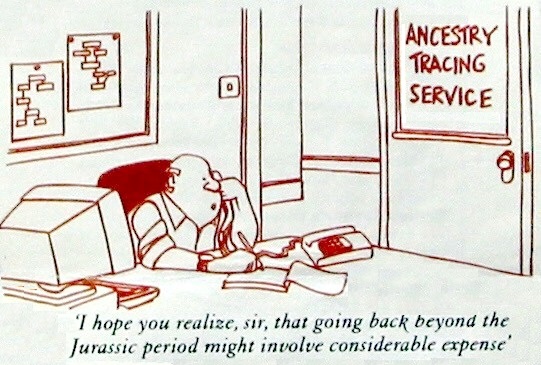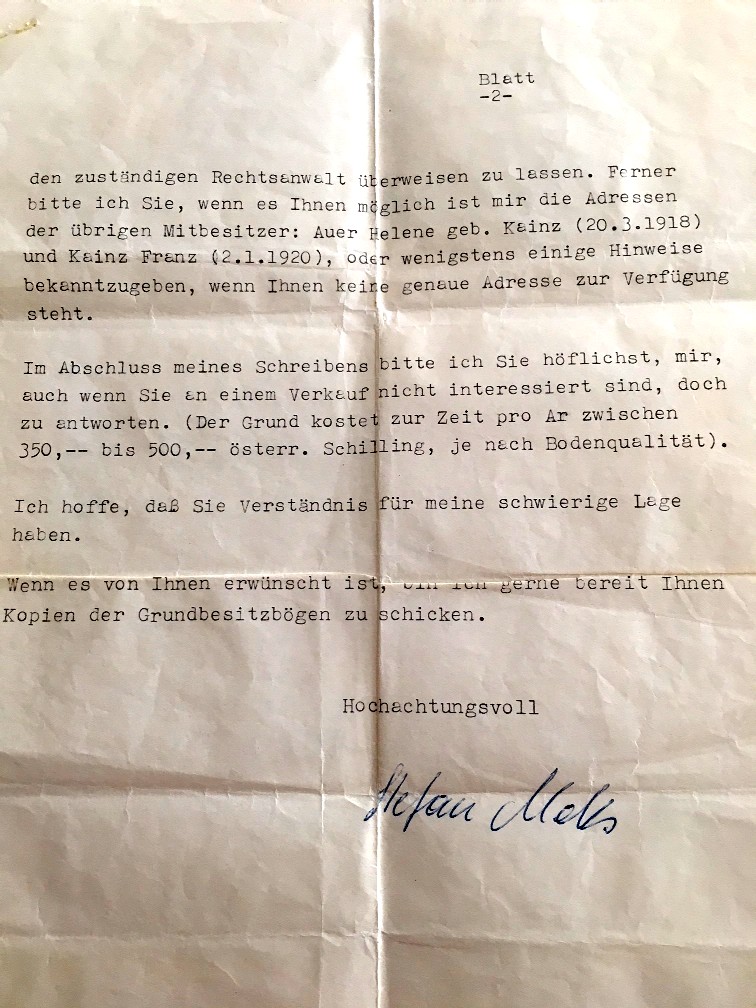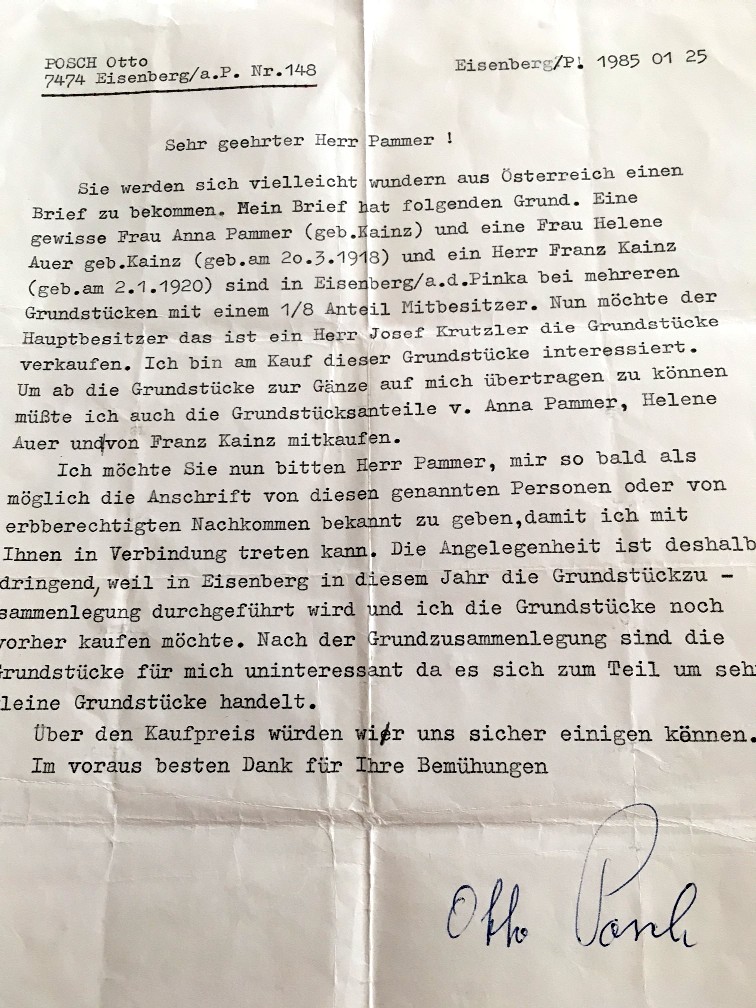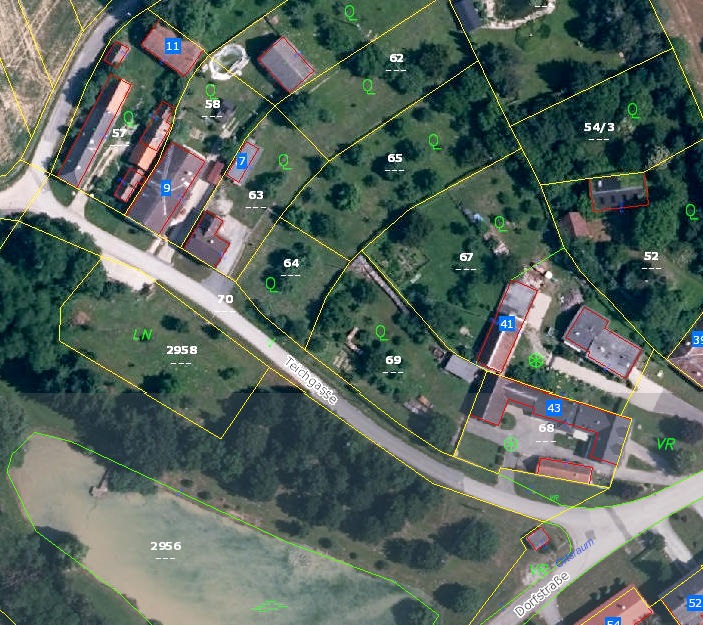|
The
|
THE BURGENLAND BUNCH NEWS - No. 269 August 31, 2016, © 2016 by The Burgenland Bunch All rights reserved. Permission to copy excerpts granted if credit is provided. Editor: Thomas Steichen (email: tj.steichen@comcast.net) Archives at: BB Newsletter Index Our 20th Year. The Burgenland Bunch Newsletter is issued monthly online. It was founded by Gerald Berghold (who retired from the BB in the Summer of 2008 and died in August 2008). |
| NOTICE: Your Editor will be traveling throughout the
second half of September, therefore, there will not be a BB newsletter published at the end
of September. |
| Current Status Of The BB: * Members: 2465 * Surname Entries: 7917 * Query Board Entries: 5571 * Staff Members: 13 |
|
1) THE PRESIDENT'S CORNER (by Tom Steichen)  After
the bits and pieces here in my "Corner," we continue with a BG-Related Trip Report
by Tom Glatz in Article 2. He attended the 60th Anniversary
festivities plus did some family-related visiting in Burgenland. After
the bits and pieces here in my "Corner," we continue with a BG-Related Trip Report
by Tom Glatz in Article 2. He attended the 60th Anniversary
festivities plus did some family-related visiting in Burgenland.Article 3 is mostly an Interesting Interview done in 1969 by John Klepeis as part of a Klepeis Family History. Emigrant grandfather Jimmy (Emrich) Klepeis is the interviewee. Article 4 presents some documents related to Land once owned by Vanessa Sandhu's Great-Grandmother, Anna (Kainz) Pammer. What did happen to her land? The remaining articles are our standard sections: Historical Newsletter Articles, and the Ethnic Events and Emigrant Obituaries sections. 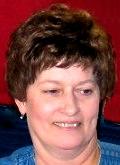 Mary
Reilly, BB E-mail List Manager, Resigns: Mary Knotz Reilly, of Savage, MN, has informed
me that she needs to resign from her post with the BB staff. While it is never enjoyable when a
trusted staff member must resign, I recognize that that time will come for all of us, so I
understand and can only thank her for her faithful service. Mary took on the post of E-mail
List Manager in October, 2010, so had been with us for nearly six years. Mary
Reilly, BB E-mail List Manager, Resigns: Mary Knotz Reilly, of Savage, MN, has informed
me that she needs to resign from her post with the BB staff. While it is never enjoyable when a
trusted staff member must resign, I recognize that that time will come for all of us, so I
understand and can only thank her for her faithful service. Mary took on the post of E-mail
List Manager in October, 2010, so had been with us for nearly six years.When she joined the staff, she wrote: "I love history, archeology, paleontology – all of those. I am mesmerized with the idea that 'my ancestors are alive today' in me (genetically speaking). I also think it’s amazing that any of them survived the wars, famines, plagues, and illness of the Middle Ages." Now, when I asked her if she had any parting words, she said: "Just say that I have relished working with all the BB people - - we all seem to share a large curiosity component - - that's what makes genealogy fun. Good luck to all. Best regards, Mary." So, along with the sadness of departure, I offer a final "Thank you, Mary!" on behalf of the staff, membership and myself. May the road ahead still have joys for you.
|
2) BG 60TH ANNIVERSARY TRIP REPORT (by Tom Glatz)  It
was an honor to receive an invitation from Burgenländische Gemeinschaft president, Walter It
was an honor to receive an invitation from Burgenländische Gemeinschaft president, Walter
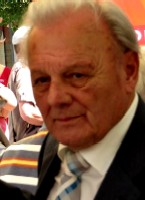 Dujmovits,
to go to Austria to take part in the festivities of the sixtieth anniversary of the founding of
the organization. The series of events from July 8th to July 12th created lasting memories. Dujmovits,
to go to Austria to take part in the festivities of the sixtieth anniversary of the founding of
the organization. The series of events from July 8th to July 12th created lasting memories.Burgenland Bunch / Burgenländische Gemeinschaft members Klaus Gerger and Bob Strauch, along with Klaus’ daughter Vicki, greeted me at the airport in Vienna on Friday. We immediately left for the south of the Burgenland with a couple of stops along the way. The first stop was a high point overlooking the town and castle of Bernstein. 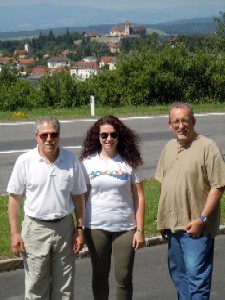 Bernstein is known for its Edelserpentine stone, which is mined nearby and made into
jewelry and other objects. There we took pictures of the beautiful landscape. The next stop was
lunch in Pinkafeld, at the Weinstube Familienbetrieb Szemes. The owners are relatives to
the wine merchant, Georg Szemes, who came to Chicago in 1956 to document the immigrants there
(see BB Newsletter No. 133B, Article 6). We then proceeded to our rooms in Deutsch
Tschantschendorf at the Walits-Gutmann Gasthof. In the evening we were treated to a “Heimat
Abend” at the Kastell Stegersbach. Rudi Pietsch and his music group, the
Tanzgeiger, played the old traditional Burgenland and Austrian music. Bob Strauch joined in
playing the button box for much of the event. I might add I had wonderful Gulasch and
Blaufränkisch wine in the restaurant below.
Bernstein is known for its Edelserpentine stone, which is mined nearby and made into
jewelry and other objects. There we took pictures of the beautiful landscape. The next stop was
lunch in Pinkafeld, at the Weinstube Familienbetrieb Szemes. The owners are relatives to
the wine merchant, Georg Szemes, who came to Chicago in 1956 to document the immigrants there
(see BB Newsletter No. 133B, Article 6). We then proceeded to our rooms in Deutsch
Tschantschendorf at the Walits-Gutmann Gasthof. In the evening we were treated to a “Heimat
Abend” at the Kastell Stegersbach. Rudi Pietsch and his music group, the
Tanzgeiger, played the old traditional Burgenland and Austrian music. Bob Strauch joined in
playing the button box for much of the event. I might add I had wonderful Gulasch and
Blaufränkisch wine in the restaurant below. On Saturday we visited the once shuttered St. Emmerich’s Church, just across the border from Inzenhof in Hungary. After viewing many different old wine cellars and buildings at the Kellerviertel Heiligenbrunn, we met Klaus’ wife Heidi, daughters Eva and Vicki, and relatives of Klaus’ wife for lunch at the Buschenschank Wolfshütte. I ordered Kümmelbraten, which is various meats marinated in caraway seeds. It was, of course, washed down with Uhudler wine. In the late afternoon, a memorial and wreath laying took place in Mogersdorf at the grave of Julius Gmoser, the second president of the Burgenländische Gemeinschaft. There were many Burgenländische Gemeinschaft members present. Afterwards we were invited to former BG secretary Renate Dolmanits’ for Salzstangerln, Strudl, and wine. In the evening we all ended up at the Gasthaus Zum Türkenwirt, also in Mogersdorf. Inside there were murals commemorating the battle with the Turks in 1664 in the area of Mogersdorf and St. Gotthard. Peter Drauch was awarded an honorary membership in the Burgenländische Gemeinschaft for his work in the First Burgenländer Beneficial Society in New York. The various members present from around the globe were recognized and there were many “Prosits.” On Sunday, we attended a Mass said by Bishop Zsifkovics in the Basilica in Güssing. It was a moving event with beautiful music. After church, “Frühschoppen” was held, which included a modern singer and the Güssinger Stadtkapelle. 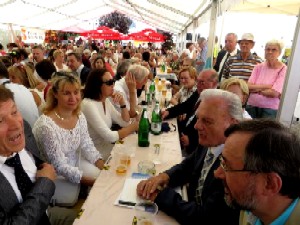 My
cousin, Bernhard Lackner, and his wife, Bernadette, attended the Früschoppen and the
picnic in Moschendorf that followed. At the picnic, there was lots of music and dancing, as well
as a choral group. Many speeches were given by politicians and others. I was presented with the
“Verdienstkreuz” (service medal) for my work done as vice president of the Chicago
Burgenländische Gemeinschaft, by Landeshauptmann (Governor) Hans Niessl.
Congratulations were given by Professor Dujmovits and SPÖ politician Verena Dunst. My
cousin, Bernhard Lackner, and his wife, Bernadette, attended the Früschoppen and the
picnic in Moschendorf that followed. At the picnic, there was lots of music and dancing, as well
as a choral group. Many speeches were given by politicians and others. I was presented with the
“Verdienstkreuz” (service medal) for my work done as vice president of the Chicago
Burgenländische Gemeinschaft, by Landeshauptmann (Governor) Hans Niessl.
Congratulations were given by Professor Dujmovits and SPÖ politician Verena Dunst.
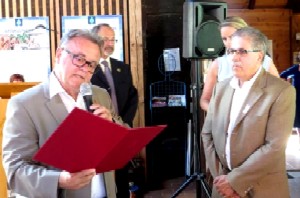 Pictures
were taken for the local newspaper and crews from the television station were on hand. Miss
Burgenland of New York, Caitlin Martin, was introduced to everyone. Sunday night it was back
to the Buschenschank Wolfeshütte. The owner gave Bob Strauch his button box. Bob and
Peter Drauch’s mother sang old Burgenland Lieder for hours. I noticed also Peter Drauch
playing the Austrian card game of Schnapsen with his uncle Rudi and others. Pictures
were taken for the local newspaper and crews from the television station were on hand. Miss
Burgenland of New York, Caitlin Martin, was introduced to everyone. Sunday night it was back
to the Buschenschank Wolfeshütte. The owner gave Bob Strauch his button box. Bob and
Peter Drauch’s mother sang old Burgenland Lieder for hours. I noticed also Peter Drauch
playing the Austrian card game of Schnapsen with his uncle Rudi and others. Bob and I went on a short trip to Graz on Monday. We visited with his friend, Karin Bertalanics. We had delicious breaded and fried Emmentaler cheese at the Krebsenkellar. Klaus also bought us some Kürbiskernöl (roasted pumpkin seed oil) from a local farmer in Deutsch Tschantschendorf. Thank you Klaus! Tuesday found us off to Eisenstadt early on the bus. We were welcomed to a wine reception at the Landhaus by Landeshauptmann Niessl. We went to another tasty reception held by Bishop Zsifkovics in his wine cellar. He gave us gifts of a religious Burgenländisches Jahrbuch and a rosary from the Maria Zell shrine in Styria. The bus then traveled to the historic city of Rust. The houses and other buildings have Baroque and Renaissance facades. Stork nests rest on the roofs. We toured the medieval Fisher Church, began in the 12th century. It is famous for its early frescoes. 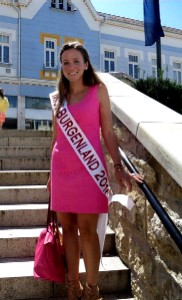 We
concluded this tour with a glass of wine! Another stop was to the “Seefestspiele”
(playhouse by the sea) in Mörbisch. We were given a tour of the behind-the-scenes areas,
including dressing and props rooms. Finally, our last stop was back in Moschendorf for the
Weintaufe (wine tasting). Again speeches were made. The wine of the evening was a 2016
Welschriesling and a 2016 Blaufränkisch (Weinhof Gasser). Both were aptly named “Caitlyn.”
Music was played and a good time was had by all! Good-byes were said and it was off to
Lockenhaus in south central Burgenland with my cousin, Bernhard Lackner. We
concluded this tour with a glass of wine! Another stop was to the “Seefestspiele”
(playhouse by the sea) in Mörbisch. We were given a tour of the behind-the-scenes areas,
including dressing and props rooms. Finally, our last stop was back in Moschendorf for the
Weintaufe (wine tasting). Again speeches were made. The wine of the evening was a 2016
Welschriesling and a 2016 Blaufränkisch (Weinhof Gasser). Both were aptly named “Caitlyn.”
Music was played and a good time was had by all! Good-byes were said and it was off to
Lockenhaus in south central Burgenland with my cousin, Bernhard Lackner. On Wednesday, my cousin took me to the Hianzverein-Haus der Volkskultur in Oberschützen. There we viewed the interesting library. Then it was off to my grandfather John Glatz’s village of Loipersdorf. I had lost contact with relatives from there over the years. We decided to inquire at the village hall (Gemeinde) about any relatives that are still living. The Gemeinde was very friendly and helpful. They directed us to the house of Frau Elisabeth Resch, born Glatz and a distant relative I hadn’t seen in over twenty-five years. We met with Frau Resch and her daughter-in-law, Christina Resch. They were very happy to see us. Frau Resch said that they had lost complete contact with anyone from America. She remembered that I had written for years to her deceased sister, Elfriede. Christina took us to the cemetery and I took many pictures of gravestones. I might add that the village hall gave us a nice booklet for free: Gemeinde Loipersdorf-Kitzladen Leben im Einklang mit der Natur. The book has some pages of history and the rest is of current times. Frau Resch and her daughter said they would very much like to keep in contact! Thursday brought us on a long walk to the village of Hammerteich with Bernhard’s dog, Lady. My grandmother, Maria Schlögl, was born there. I took a picture of where my grandmother’s house once stood. Then we went to the cemetery for pictures of headstones. Back in Lockenhaus, I took pictures of more recent burials of relatives. 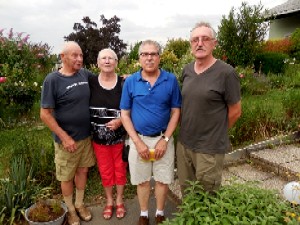 In
the afternoon, when Bernhard’s wife Bernadetta returned from work, we drove to visit his sister
Anni and her husband “Schurl” or Georg Heinrich in Deutschkreutz. After coffee and Torte, we
went to the Catholic Church, sometimes referred to as the “Lemden Kirche.” Professor
Anton Lemden painted a large mural on the outside of the church. He also painted the Stations of
the Cross on the inside. We visited the old Jewish quarter and cemetery in Deutschkreutz. Almost
all of the gravestones were destroyed by the Nazis during World War Two. We then ate at a nice
Buschenschank that I cannot remember the name of! In
the afternoon, when Bernhard’s wife Bernadetta returned from work, we drove to visit his sister
Anni and her husband “Schurl” or Georg Heinrich in Deutschkreutz. After coffee and Torte, we
went to the Catholic Church, sometimes referred to as the “Lemden Kirche.” Professor
Anton Lemden painted a large mural on the outside of the church. He also painted the Stations of
the Cross on the inside. We visited the old Jewish quarter and cemetery in Deutschkreutz. Almost
all of the gravestones were destroyed by the Nazis during World War Two. We then ate at a nice
Buschenschank that I cannot remember the name of!On Friday, we went to the Landesmuseum Burgenland in Eisenstadt. There were interesting exhibits on archaeological finds from all over Burgenland, including prehistoric, Roman, and medieval times. An exhibit on wild geese called “Dumme Gans” (dumb goose) proved that geese are just the opposite! We decided to make a quick stop in Kobersdorf. The castle was closed, but I was able to take a picture of it along with the synagogue and Jewish cemetery (both of which are still intact). The synagogue was saved because it was too close to the castle, which might also have been destroyed. In the evening, my cousin’s future son-in-law grilled wonderful paprika marinated pork chops and bratwurst. I also want to mention the other books which were given to me. My cousin Bernhard gave to me: Orts, Fluss und Flurnamen im Burgenländisch-Pannonischen Raum, Erwin Schranz, 2008 (Towns and Villages, Rivers and Streams, Hills and Meadows in the Burgenland-Panonnian Realm). This is a book of essays dealing with geographic designations of the names of towns, villages, rivers, streams, hills, and meadows. Erstes Burgenländisches Familiennamen Buch by Isolde Hausner, Christiane M. Pabst and Erwin Schranz, 2011 (First Burgenländische Family Names book). This is an explanation of many Burgenland last names. Historischer Atlas Burgenland, authors too many to mention, 2011. 750 Jahre Lockenhaus, Denise Steiger-Nuschy, 2007. Landeshauptmann Niessl gave to all of us: Das Burgenland an der Zeitenwende, Schau Media, 2013, which is a book mostly on the history of Burgenland. There are also great old pictures in the book. I am very grateful to Klaus Gerger and my cousin Bernhard Lackner. The trip would have been impossible without their help! |
3) THE KLEPEIS FAMILY HISTORY (by John Klepeis) Ed Note: Kevin Klepeis, who joined the BB in July, shared with the BB staff a Klepeis Family History and family tree written and prepared in 1979 as a school project by a second cousin, John Klepeis. Kevin has kindly given permission to share it with the membership as we see fit. This article includes the Preface, Introduction, and the Oral History Interview Transcript that John included in his report. We share these particular parts of the report because they are typical of both the research difficulties in uncovering such a family history and of the life experiences that emigrants had. The remaining parts (the family tree, information about family members, etc.) are not of general interest (though if you are part of this family, do contact me or Kevin for more information!). Kevin also asks that I mention that if any reader has further research or information on Alouis Klepeis, father to the interviewee, and/or Alouis' mother, Mary Klepeis, to let him know. Kevin will be in Europe in April 2017 and plans to swing through Burgenland and Hasendorf from April 22nd-26th. He also notes that if there is anyone who would be able to give him a little guidance about Hasendorf and/or its records, that would be very much appreciated. John Klepeis' 1979 text follows... PREFACE The information for my family history came from oral histories. I taped an interview with my Grandfather Klepeis. This I have transcribed. Additional facts came from informal interviews with my grandfather Klepeis and his brother, Mike. I also wrote letters to key members of the family, both American and Austrian, My father was able to translate my letter into German so that those in Europe could understand it. I received a few pictures from the relatives in Europe. I received most of the information for the Genealogy Chart [not shown herein] through the letters. My father had some slides which he took in 1974 on his trip to Austria with my Grandfather Klepeis. They show where the old family farmhouse had been and the remains of the barn. My grandfather had not been back to Austria for over fifty years. They stayed with Maria Mikovits, the sister who was a child when he last saw her. The major difficulty in writing this history was that no one before me had ever written anything down. When the brothers came to the United States, they did not bring any pictures or records. There was no accumulation of knowledge to draw upon. Mary Klepeis, the grandmother of the Klepeis brothers, remains an enigma. Because her son Alouis was born out of wedlock, the usual marriage and christening records are missing. The name of his father is unknown, and any details about Mary's origins lacking. Because none of the relatives live in Massachusetts, I could not visit churches or graveyards, I had no addresses to send for birth and death records. The brothers all settled in the New York-New Jersey area (metropolitan New York), but I could not pinpoint specific churches or courthouses. The Klepeis brothers as youngsters were more concerned with working and getting enough to eat than learning of their forebears. Their parents volunteered little information. For all practical purposes, the boys left home at thirteen. Their education and cultural background were not geared toward gathering or recording family history. Fortunately, the older generation of the family has kept in close contact, so it was possible for me to use their memories extensively. INTRODUCTION The Klepeis family was a typical European farming family. They grew up in a rural farming town called Hasendorf [in Burgenland]. This hamlet in the Austro-Hungarian Empire had a population of about fifty. There was a general store where such items as sugar, spices, machinery, and other basics could be purchased. There was a flour miller and a weaver in town. An inn, which included a saloon, attracted townspeople. The local school was run by the Roman Catholic Church, but the church was in a neighboring town. Most of the people were quite poor. The dominant figure in the community was the Count. He allowed the farmers to cut wood in his forest and most worked his land as share-croppers. Alouis and Mary Klepeis lived in Hasendorf. Alouis did spend three years working in the United States, while Mary remained behind to tend farm and family. From 1891 to 1917, eleven children were born to them. All were born at home and all lived to adulthood. It was a hard life with not enough land to go around. Seven of the children chose to seek a new life in the United States and one was adopted by relatives. Their story is typical of many immigrant families at that time in United States history. ORAL HISTORY INTERVIEW TRANSCRIPT November 23, 1978, Bronx, New York Q: = John Klepeis A: = James (Emrich) Klepeis; Grandfather [born 1900, emigrated 1921] Q: What is your full name? A: My name? Emrich Klepeis. My name is not Jimmy. My name is Emrich. Q: Did you assume the name of James when you came here? A: They gave me that nickname over here. They say, that's Jimmy. I don't believe them. But my name is Emrich Klepeis. Q: Where were you born? A: I was born in Hungaria (Hungary). Q: Can you tell me the town? A: Hasendorf. In 1900. October 14. Q: What was your father's name? A: The father's name was Alouis Klepeis. Q: What was your mother's maiden name? A: Maria Ivankovits. Q: Where was your father born? A: He was born in Hasendorf. Q: Do you know what year? A: I believe it was in 1867. Q: Where was your mother born? A: She was born in Tobaj, in 1871. Q: Do you remember your grandfather's name? A: I never knew him, no I don't know that. Q: Your grandmother? A: No, I don't know that. I didn't know none of them. Q: What was your father's occupation? A: Farmer. Q: How many brothers and sisters did you have? A: We were nine brothers and two sisters. You want the names? Q: And maybe if you could the dates when they were born. A: That I can't tell you. Not the dates. I could tell you the year. Q: That's fine. A: The oldest was born in 1891. His name was Alouis like the father. The next one was Mike. He was born in 1893. The next one was Joe, 1898. Then I was born in 1900. Then Frank was 1902. Then was Eddie, 1907. The next one was Gus, 1908. Then was the sister Anna, 1909. Then was John, 1910. Then was Mary, 1913. Then was the last brother Richard, 1917, he's dead already. And that's the end. Q: How many of them are still alive? A: There is the brother Frank. He's in Austria. The sister Maria. That's all. Q: And you and Mike? A: Me and Mike and Eddie. We in this country. Maria and Frank is over on the other side. Q: How many people lived in the village or town where you grew up? A: It was a small town. I say approximately fifty. Q: Was it a farming community? A: All farmers. Q: How many churches were in the town? A: We had no church in our own town. We went to the neighboring town. It was like a community church. Q: Was it any particular denomination? A: It was Roman Catholic. Q: Did you go to church once a week? A: When we went to school we had to go to church. The school was through the church. Because we went to Roman Catholic church we had to go to school. We had the confession, the communion, baptism and all that stuff. We had to go. Q: So the church ran the schools that you went to? A: Absolutely... We belonged to, at that time, Hungary and that was ruled by the principal who came once a week to the school to check up. Q: Did the nuns teach you or who were the teachers? A: We had regular teachers. Up to the second grade we had a woman teacher and from the third grade up we had a man teacher. We only went to the twelfth grade; we only went six years. That's all we went. Q: Twelve years old you mean. A: Yeah, twelve-, thirteen-years-old you graduate. Q: How far away was the church in the other town? A: The nearest church that we belong to was only about a mile away. Q: Did you have to walk? A: We had to walk, we had no other transportation. Even if the snow was three foot deep, we walk. Q: Didn't your family have any horses or anything? A: No we use cows. We plow the field and everything in cows. We had no horses, no oxen. Q: But you didn't use them to pull a wagon? A: Absolutely, we use the cows for everything, They pull a wagon, they pull a plow. We usually had four cows. Q: Did they give milk too? A: They give milk. We didn't sell no milk but we had enough for the household. We had enough butter and everything. We had enough food to live. We didn't have a big farm. There was a Count, he had a big estate. We work for him. Ya know, like sharecropping. Q: Oh, you mean on the Count's land. You would work his land and then be able to take some home? A: That's right. We always had enough to eat. Our father was a very handy man. He made all the farm tools. He didn't buy nothing except machinery. Q: How old were you when you came to the U.S.? A: I was twenty-one. Mike was about twenty-one; Louie was sixteen; Eddie was about twenty. The sister was about eighteen. We was six brothers here and one sister. But the sister was diabetic; she died aboard ship (going back to Austria) and was buried in Kuckshaben [likely Cuxhaven], Germany. My younger brother, Frank, was adopted by the uncle because the uncle's only son died in World War I. He had nobody, so he adopted our brother, Frank. Q: Was there a church bell? A: We had a bell in our own town (even though no church). Q: What was the bell used for? A: In the town, the bell was only used for the time. Q: Was it used if there was an emergency? A: Yeah, it was used in case of fire, but it was a different tune then. Q: Was the graveyard near the church? A: No, the graveyard is in our own town. My father was ninety when he died and the mother eighty-seven. Q: Was it unusual for people to be that old? A: Some live longer; some die sooner. My mother had eleven children and she lived to eighty-seven. She done everything; she sewed underwear; she made shirts; she sewed pants. We used to grow the cotton and she used to spin the thread with a spinning wheel. She had an old Singer sewing machine and done all that sewing work through the winter. Q: Did she weave the cloth? A: No, she sent it to the weaver. There was a weaver in town. Q: When you went to school, was there one big classroom or were there separate classrooms for different grades? A: There were two schools; one for first and second grade and one for third through sixth. There was two different sections, too, one for the girls and one for the boys. Q: What subjects did you study? A: Well, we studied a little of almost everything. Q: Did you study English? A: No. Q: So, you didn't know English when you came to this country? A: I did not. I spoke German and Croatian at home, and we learned Hungarian and German in the school. So we were learning three languages at the same time. Q: What was your favorite subject? A: I did not have a favorite subject. Q: Did you study geography, arithmetic, things like that? A: We had a map. Each class had a different kind of map. We studied the map, and we learned how to read and write and do arithmetic. Q: Did you have to wear a uniform? A: No, we didn't wear no uniform. Q: Did you have many books? A: The parents had to buy the books. On Wednesday and Friday was religion. We were all Roman Catholics. On Wednesday, we had catechism; on Friday, we learned the Bible. Q: It must have been hard for your parents to send all those children to school and buy all the books. A: No, we passed the books down and we usually managed. Q: Did you play sports in school? A: No, we had no sports. It was nine to twelve, we had one hour for lunch, and then from one to four. That was all school; no sports. They're strict over there in school. Q: Was there a police system to take care of crime? A: We had a sheriff. He took care of those things. If you committed a bigger crime, it went to the state capital. Q: How long was the school year? A: September to June. Q: What did you do during vacation? A: Work on the farm. Q: Was there a doctor or hospital in your town? A: In the next town, there were two doctors and a hospital. Q: What were some of the common diseases? A: We had measles and stuff like that. We had a lotta home remedies. Q: Was there a post office in town? A: Yes, in the next town. The teacher took care of the post. Q: Did you have a newspaper? A: There was a weekly newspaper, but my father usually got the monthly magazine. Q: Was there a general store? A: There were stores. We had a couple of inns, saloons, which were called Gasthaus, and hardware stores, grocery stores, delicatessens. Once in a while, we had a big dance and everybody got together to have a good time. Q: Did you have a railroad coming through town? A: There was a railroad, and in later years we had buses. Q: Do you remember the first time you saw an automobile? A: I must have been about six years old. The Count had an automobile. He had a chauffeur too. Q: Did you have any contact with radio or television? A: No, there was no such thing at that time. Q: What did people do in their leisure time? A: Oh, they'd go out and have picnic. Have a couple of drinks together and enjoy themselves. Q: Was there a library? A: Not in my town. In the school, they had books. Q: When was the first time that you saw an airplane? Was it in this country? A: No, it was in Europe. It was before the 1920's. Q: What was your reaction? Were you surprised? A: No, I was not surprised. We knew about them from about 1914. Q: Why did you leave home after schooling? A: At home, there was no money. Our father, he gave you eats, but no money. So I went out to work as a farm hand when I was thirteen. I traveled around, getting whatever job I could. I worked on the railroad, in gardening, picking beets. We were sometimes paid money and sometimes paid grain. After two years of working away from home, I went home. There was a plebiscite (a vote) and when we got home, we belonged to Austria! Q: Did you have to have any kind of visa or work paper to travel from one country to another to work? A: We had a passport. Q: Did you have dual citizenship after the plebiscite, or were you transferred from Hungarian to Austrian? A: I was a Hungarian citizen because of being born there; but I lost the Hungarian citizenship and became Austrian; then I became an American citizen here. Q: How big was your house in Austria? A: We had one big room; we had a kitchen and two cellars. We had a big barn about a hundred feet long and an extra barn. We were a big family, but we were clean. We had fleas - you couldn't help that - but we never had lice. Our mother washed and we changed our clothes once a week; we had a big wooden tub to take a bath. We didn't have no running water in the house. We had a well in front of the house. My mother was a good cook. She used to make the big loaves of bread. They used to put five loaves of bread In the brick oven. Q: Did you cook on a fire or a stove? A: We had an open fire and the oven. You heat up the oven and when it was hot you pulled the fire out and pushed the bread in. The oven was right in the fireplace. Q: Did you use coal or wood? A: Wood. Q: Did you have electricity? A: Not in my time. We had kerosene lamps. Q: What animals did you have other than cows? A: We had cows, pigs, thirty to thirty-five chickens, one rooster, a couple cats, and a dog. Mother sold some eggs to buy salt and pepper. We grew everything except salt, pepper, and sugar. We grew corn, rice, wheat, buckwheat, oats, and all kinds of vegetables such as turnips, pumpkins, carrots, and potatoes. We never sprayed anything; we had no insects. We had an orchard with about one-hundred-fifty fruit trees: plums, apples, prunes, pears, grapes. We made our own cider. For meat, we had chickens and pigs. We didn't have much meat but ate a lot of noodles and things made with flour. We had the grain for flour ground at a mill. Q: Did you have a family Bible? A: Sure, yeah, but we didn't read much in the Bible. We were not too religious, but we went to church. We had to go to confession in school. Q: Did your family own any other books? A: Just from school books. We had a history book that I would like to have. Q: Where did you store food? A: We had a cellar in the ground to keep it cool. The walls was very thick, so it was always cool. It was not very humid there in summer. We had a lot of woods and forests and no industry. Q: Did you celebrate Christmas? A: Christmas is a big holiday. Q: Did you give gifts? A: No, we had a different system. We school boys would go from town to town, wishing people a Happy Christmas. They would give us money or fruit, things like that. Q: Did you give anything in return? A: No. Q: Did you make gifts for the family members? A: No, not that. Q: Did you have toys? A: No, we didn't have toys. We had a nice Christmas tree. We went out in the woods and cut a nice tree. The tree was decorated with fruit. Everything hanging on the tree was edible. On the sixth of January we took it off and ate it. Q: Were your parents strict? A: In the way of religion, not strict. But otherwise, very strict. You had to obey. Just like at school, you obey, or they slap you. Q: At what age did people marry? A. In the middle twenties; not too early. Q: Why not? A: It was the custom. Legal age was twenty-one. Q: Did your father have tobacco at home? A: Yeah, we had cigarettes, tobacco, all that stuff. My father smoked a clay pipe. One day me and one of the neighbor boys stole the pipe and filled it with oak leaves. Boy did we get sick smoking those oak leaves! Q: Did your father have a rifle or gun? A: He had a gun that my brother brought back from the war. Q: How did you preserve a pig when you killed it? A: After killing, we hung it up, quartered it and cut it all up. Then we salted it and cured it and hung it in the smoke house. It hung there about four weeks, We killed two or three of them during the winter. In the winter, you mended your tools, made firewood, and played cards. Eats, you have, because after the harvest, everything is filled up. You load up a wagon full of grain and take it to the flour mill, and then it is used by the mother for cooking. Q: What kind of bread did you have? A: Rye bread. Mother made five loaves; they baked for two and a half hours. We had a rack in the cellar to keep it. The bread supposed to last one week. Q: Why did you decide to leave Austria? A: There was no outlook for me. I had no trade. I didn't want to work on a farm. Farm work was hard work, long hours. You work from sunrise to sunset. I had three brothers over here already, so I decided to come over. Q: How did you come? A: I took a train. I lived quite a distance from Vienna and I had to get my passport and go to the American consuls. My brother sent me two hundred dollars. I was supposed to go with a group but missed that train. I had to buy another train ticket and travel alone to Paris. From there I went to Le Havre and caught up with the people. A French doctor checked us and gave us an injection. We boarded the ship, "The Line of Paris," on a Saturday afternoon. It was a six day trip. Q: Why did you decide to go to the United States and not England or someplace else? A: Nothing in Britain is any good. In the United States, you have more opportunities. Q: Who met you? A: My brothers, Louis and Mike, met me. Someone had given me a bottle of whiskey. I didn't know about Prohibition. They didn't find the bottle because if was hidden in my coat. All I had was two suits and a couple of underwears. Q: You didn't bring any family souvenirs or pictures? A: No, I had nothing. My brothers said: "Don't bring much." Q: Where did the ship land? A: In New York. Q: Where did you stay? A: I went to Passaic, New Jersey, and stayed with the oldest brother, Louis; he had an apartment. I stayed there one year. Q: Was it difficult for you to get a job? A: No, Louie got me a job. Q: Where did you go after that? A: When Mike got married, I moved there. Then we went on strike, a textile strike. Mike moved out to Clifton and I got a job in New York. I moved to New York in 1927. Q: Was it difficult to learn English? A: Louie had two little girls, Helen and Tessie. They couldn't speak German and I couldn't speak English, but we learned. Q: What was your job in 1927? A: Auto body commercial work, we painted trucks and other things. I worked there for eleven years. That is where I ruined my eyes. The fumes from the paint ruined them. The doctor said I had to get out or I would go blind. I went on strike and lost the job any ways. There was a strikebreaker. I called him a scab. I finally got a job in 1937 working as an elevator operator. I stayed there thirty-seven years, until I retired. Q: Where did you meet your wife? A: In Passaic. I knew her from Europe. Q: Did she come to the United States when you did? A: No, she came in 1928, five years later. Q: Did you live near each other in Austria? A: She came from a different town, about a half-hour walk. Q: Did you keep in contact with your family in Austria? A: That's right. Not much, but once in a while, we write. If they needed money, we sent some. At that time, we didn't have much ourselves; wages were low. Q: What did you think of electricity when you came to the U.S.? A: My brother didn't have it. Some had it, but he had gas lights. Q: Did you get your citizenship right away, so that you could vote? A: No, a number of years later. At that time, nobody bothered you about it. Later, they said it was better to become a citizen. Q: How did the Great Depression affect you? A: I was working. Summer time, we worked full, but in winter time, we worked two or three days a week; just made a living. I was getting sixty-two and a half cents an hour. Q: What did you think about the Vietnam War? A: I don't know much about those countries. Q: Were you for or against the American participation? A: I was more against it. I thought we had no business to be there. We should leave those people alone. That was French colony. I think it was Eisenhower that got in there. It was a mistake. Q: Did you ever have a car? A: No, I never did. Q: Did you ever belong to a union? A: In 1945, I joined the union. The super didn't want one. He said to me, "Jimmie, you have to go upstairs to work." I said, "I don't have to." Q: How much money did you make when you started? A: I made $96 a month in 1937. When I retired, I was making $206 a week, doing the same job. When I started, we worked sixty hours a week. Through the union, it was lowered to fifty-four, then forty-eight, then finally forty. I finally had to pay too much taxes. The wife passed away and a single person gets robbed - federal, state and local taxes. Retired, I could get one-hundred-fifty dollars a month from the union, plus social security. Q: How old were you when you retired? A: Seventy-four. Q: Was there any pressure put on you to retire at sixty-five? A: No, I could work. |
4) SO WHAT HAPPENED TO GREAT-GRANDMOTHER'S LAND? Vanessa (Bammer) Sandhu (supplier of the Burgenland recipe featured this month) also had a question regarding land in Burgenland, and she hoped that I or another member of the BB might be able to answer it. 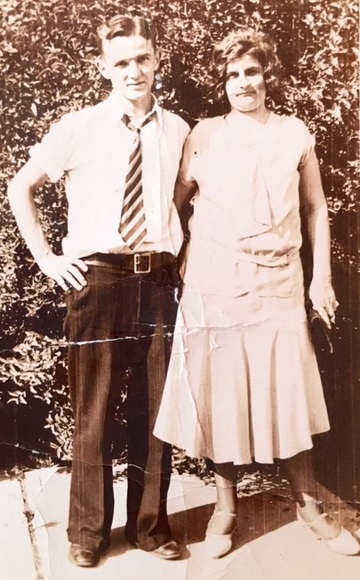 She
writes (in part): "While going through my deceased grandfather's personal effects, I
found two letters written in German. After translating them, I found that my great-grandmother
(Anna Kainz [Pammer]) was the [part-]owner of two tracts of land. The letters (one from 1966 and
the other from 1985) were both attempts to get my grandfather to sell the land. Apparently, he
was her heir after her death in 1943. My grandfather passed away in 1995. My guess is that
Austria has probably reabsorbed this land after all this time. It was in Eisenberg an der Pinka.
Do you know whom I could contact to check the status of the land? I'm sure that it is no longer
the property of our family, but I'd love to visit it in the future!" She
writes (in part): "While going through my deceased grandfather's personal effects, I
found two letters written in German. After translating them, I found that my great-grandmother
(Anna Kainz [Pammer]) was the [part-]owner of two tracts of land. The letters (one from 1966 and
the other from 1985) were both attempts to get my grandfather to sell the land. Apparently, he
was her heir after her death in 1943. My grandfather passed away in 1995. My guess is that
Austria has probably reabsorbed this land after all this time. It was in Eisenberg an der Pinka.
Do you know whom I could contact to check the status of the land? I'm sure that it is no longer
the property of our family, but I'd love to visit it in the future!"I replied: "The Land Register is online and (somewhat) accessible (you must have a password). I use it now and then but it is, of course, in legalese German. If you have some sort of description of the tracts, I could look up who is listed as current owner(s), assuming I can identify the exact tracts (via maps, tract number, etc.). Offhand, I do not recall how much time must pass before the land is considered abandoned and is sold off by the government, but there is a good chance it is still being held for an heir to claim. "It also would be possible to contact the local municipal government over there to find out what they know. Again, you will need some reasonable description of the land for them (or anyone) to act on your request. I suggest we try first and, with whatever we can learn, then contact the government." She then replied: "Thank you so much for all of your help! I will try to attach photos of the documents themselves so you can read them if you'd like. It looks like Anna's father, Franz Kainz, lived in house number 33 in Eisenberg an der Pinka. The lots appear to be Grundbuchseinlage 569, which was 16,64 Ar [0.41 acres], of which she owned half, and Grundbuchseinlage 53, which was 171,80 Ar [4.24 acres], of which she owned 1/4." Below are the letters with the 1966 (2-page) letter presented first and the 1985 letter second. Each letter is followed by a translation: 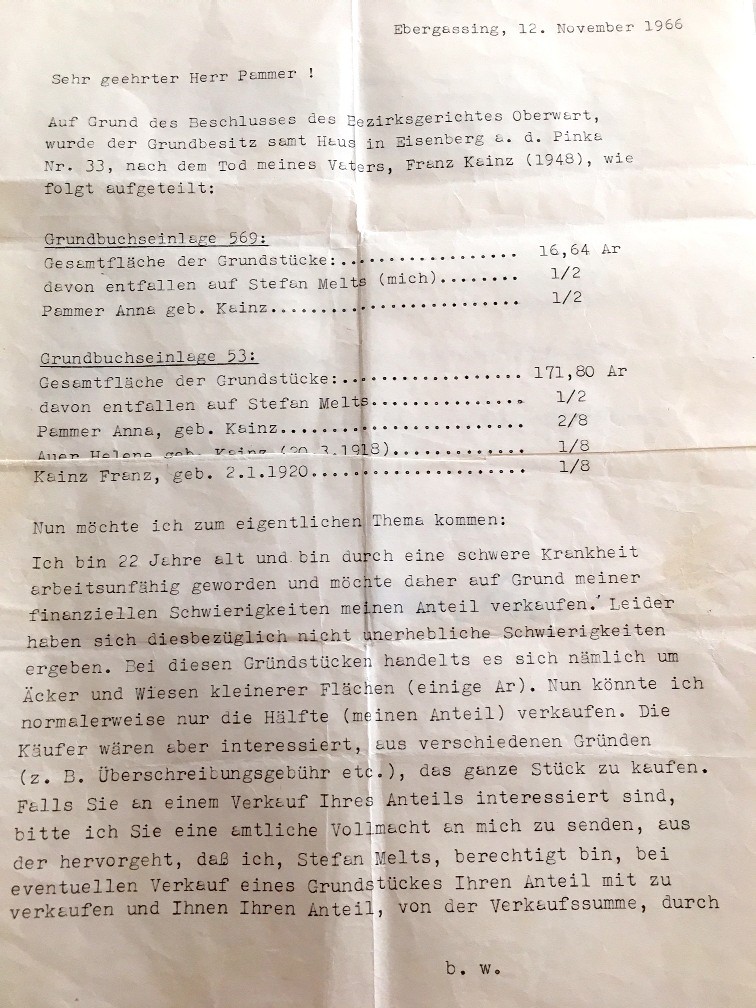
As you can see, these are quite small tracts of land (0.41 and 4.24 acres),
especially after being split two and four ways, respectively. My guess is that the first was the
house lot and the second an actual field or pasture. Using the information from the 1966 letter,
I looked for "land registry inserts" 569 and 53 in Burgenland's online Land Registry system, "GeoDaten
Burgenland," found at
https://geodaten.bgld.gv.at/nc/de/geodaten-suche/gemeinden.html (I've mentioned this system
in the BB Newsletter before). However, given the information in the second letter (that a land
amalgamation was to be performed in Eisenberg in 1985/6 and therefore that plot numbers would
likely change), I was not surprised to discover that these "land registry insert" numbers no
longer exist. |
5) HISTORICAL BB NEWSLETTER ARTICLES Editor: This is part of our series designed to recycle interesting articles from the BB Newsletters of 10 years ago. In the August 2006 edition Gerry repeated an article he first published in September of 2000, an article in which he waxed lyrical about the Danube River while talking about Burgenland. If it was a good enough article for Gerry to repeat, it is good enough for me. Enjoy! THE BURGENLAND BUNCH NEWS No. 154A August 31, 2006 TRANSDANUBIA (DUNÁNTÚL) - MOTHER OF THE BURGENLAND (by Gerry Berghold) (Previously published in BB News no. 88, dtd. Sept. 30, 2000) The name "Burgenland" was born in 1921, so if you search an English-language index for that name you find very little. If you use Austria or Hungary you get much more than what you want. Pannonia helps but often refers only to Roman times. Lately the use of that name for the Burgenland region is appearing in Austrian publications. One name that works is Transdanubia (translates to "over or across the Danube" - German: Donau - Hungarian: Duna) - this "across" presupposes you are standing in the middle of Hungary, just east of the Danube (where it flows south) and are looking west. 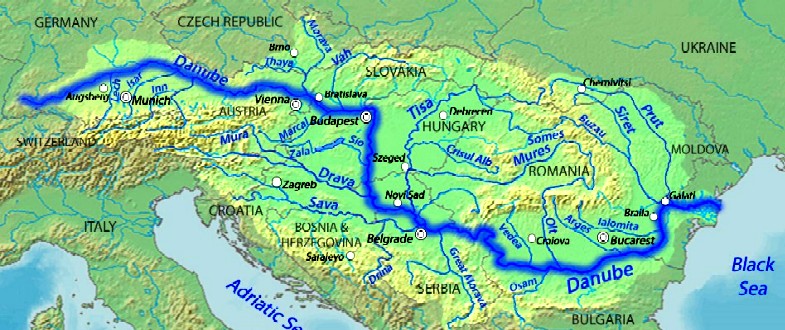 The Danube, one of the world's mightiest rivers, stretches from the Black Forest of southern Germany to the Black Sea. It runs east through Regensburg and Passau, Germany, to Vienna, Austria and on to Bratislava, Slovakia, and then continues to Budapest, Hungary where it abruptly heads south to Mohacs, Hungary and again turns in an easterly direction to Belgrade, Serbia. It continues east, forming the border between Romania and Bulgaria, before emptying into the Black Sea. We were fortunate in being able to cover the entire distance (from Passau, Germany) by riverboat a few years ago. An eight-day odyssey of much historical interest. Later we traveled from Amsterdam to Vienna using the Rhine, Main, Rhine-Main Canal and Danube and thus have been able to cross Europe by riverboat. Unlike the highway, river travel provides scenes rarely seen elsewhere. Travel writers will tell you that the "Beautiful Blue Danube" of the Strauss waltz is not blue but a muddy brown. We've found that, on a warm, sunny afternoon following a long wet lunch with the riverbanks slowly passing by, the river is beautiful and as blue as the sky. Likewise on a soft summer night, following a well-wined dinner, with wife in hand and a waltz playing in the background, it can be a romantic, star studded, glistening deep blue - so much for reality! I'm sure that's how Strauss saw it and that's how we remember it. On its banks you'll see fishermen's huts, stock and geese being watered, women washing clothes, crumbling castles, and river hamlets, not to mention urban bridges, promenades, shipping quays and one mighty dam, but bucolic scenes still predominate. Between urban areas you can still see bits of "old Europe" - and imagine the whole historic panorama. 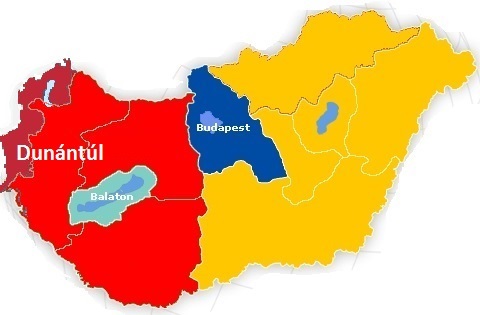 This
introduces the name Transdanubia [Hungarian: Dunántúl], whose western region
includes our Burgenland, ending at the border with Styria and Lower Austria. This area
[Burgenland] is unique in that it is hill country (Hügeland), neither alpine nor plain.
It has a different geography. It also has an older history and has always been borderland and a
racial melting pot. The mixture has spawned a unique culture, part German, part Magyar, part
Slav. The portions of interest to us, from north to south, start with the Leitha River region
below Vienna and the Neusiedlersee. As we drop south from the Neusiedlersee we come to many
other streams which wend their way to the Neusiedler or eventually, after joining other rivers,
empty into the Danube. Among them are the Leitha, Wulka, Rabnitz, Pinka, Lafnitz and Raba. They
add their names to many of our Burgenland villages. We've just delineated a major part of what
was the Roman Province of Pannonia and what we consider the best of Transdanubia,
truly the mother of the Burgenland. This
introduces the name Transdanubia [Hungarian: Dunántúl], whose western region
includes our Burgenland, ending at the border with Styria and Lower Austria. This area
[Burgenland] is unique in that it is hill country (Hügeland), neither alpine nor plain.
It has a different geography. It also has an older history and has always been borderland and a
racial melting pot. The mixture has spawned a unique culture, part German, part Magyar, part
Slav. The portions of interest to us, from north to south, start with the Leitha River region
below Vienna and the Neusiedlersee. As we drop south from the Neusiedlersee we come to many
other streams which wend their way to the Neusiedler or eventually, after joining other rivers,
empty into the Danube. Among them are the Leitha, Wulka, Rabnitz, Pinka, Lafnitz and Raba. They
add their names to many of our Burgenland villages. We've just delineated a major part of what
was the Roman Province of Pannonia and what we consider the best of Transdanubia,
truly the mother of the Burgenland. |
6) ETHNIC EVENTS LEHIGH VALLEY, PA Sunday, Sep. 4: Parish Picnic at St. John the Baptist R.C. Church in Whitehall (Stiles). Friday, Sep. 9: National Wienerschnitzel Day at the Reading Liederkranz. Info: www.readingliederkranz.com Sunday, Sep. 11: Oktoberfest at the Coplay Sängerbund. Music by the Josef Kroboth Orchestra. Info: www.coplaysaengerbund.com Friday, Sep. 16: Oktoberfest Kickoff Party at the Reading Liederkranz. Music by The Jolly Bavarians. Info: www.readingliederkranz.com Friday-Sunday, Sep. 16-18: Oktoberfest at the Lancaster Liederkranz. Info: www.lancasterliederkranz.com Saturday, Sep. 17: Button Box Festival at the Reading Liederkranz. Info: www.readingliederkranz.com Sunday, Sep. 25: Oktoberfest at the Holy Family Club in Nazareth. Info: www.holyfamilyclub.com Wednesday, Sep. 28 - Sunday, Oct. 2: Oktoberfest at the Reading Liederkranz. Info: www.readingliederkranz.com Friday-Sunday, Sep. 30 - Oct. 2: Oktoberfest at Steel Stacks in Bethlehem. Info: www.steelstacks.org/festivals/oktoberfest/ Friday-Sunday, Oct. 7-9: Oktoberfest at Steel Stacks in Bethlehem. Info: www.steelstacks.org/festivals/oktoberfest/ Saturday, Oct. 15: Weinlesefest at the Lancaster Liederkranz. Info: www.lancasterliederkranz.com NEW BRITAIN, CT Friday, September 2 and October 7, 7 pm: Heimat Abend. Austrian Donau Club, 545 Arch Street, $3. Music by Joe Rogers and his band. Friday, September 16 and October 14, 7:30 pm: Heurigan Abend. Austrian Donau Club, 545 Arch Street, $3. Music by Schachtelgebirger Musikanten. ST. LOUIS, MO Sunday, November 6, 2016, 2-5 pm: St Louis Gathering of Burgenländer and Descendants, at the Community Center Cafeteria of the Holy Name of Jesus Catholic Church, 10235 Ashbrook Dr, St. Louis. Contact Theresa McWilliams at tmacwms@sbcglobal.net for more information or to say you plan to attend. |
7) BURGENLAND EMIGRANT OBITUARIES Sidonia Wietstruk (née Posch)  Sidonia Wietstruk, 84, passed away on Wednesday, August 24, 2016 in Macon, Georgia. Born on October 8, 1931 in Pinkafeld, Austria, Mrs. Wietstruk was a daughter of the late Joseph and Hermine Posch. She enjoyed her job as a housekeeper which she did for many years becoming very close to the families she worked for. In her spare time, Sidonia enjoyed crocheting and gardening and was well known for her green thumb. She was a loving and devoted mother, grandmother and sister who will be greatly missed by all. She is survived by two sons, Eric Carl Wietstruk (Theresa) of Bonaire, GA; Clifford Wietstruk (Nicole) of Pasadena, MD; and five beloved grandchildren David Karl Wietstruk (Jennifer) of Vienna, Austria; Eric Michael Wietstruk (Tabitha) of Auburn, AL; Chase, Jordan and Olivia Wietstruk all of Pasadena, MD. Along with her parents, she was preceded in death by one son, Richard Wietstruk. Funeral Services will be held on Tuesday, August 30, 2016 at McCully-Polyniak Funeral Home Pasadena, Maryland. Heritage Memorial Funeral Home in charge of arrangements. Please go to www.heritagememorialfuneralhome.com to sign the online guestbook. Published in The Telegraph on Aug. 26, 2016
|
| END OF NEWSLETTER (Even good things must end!) |
NOTICE (Terms and Conditions): The Burgenland Bunch (BB) was formed and exists to assist Burgenland descendants in their research into their heritage and, toward that end, reserves the right to use any communication you have with us (email, letter, phone conversation, data upload, etc.) as part of our information exchange and educational research efforts. • If you do not want your communication to be used for this purpose, indicate that it is "confidential" and we will abide by that request. • Correspondents who communicate with the BB without requesting confidentiality retain their copyright but give a non-exclusive license to the BB allowing us to forward to BB members, publish in our monthly newsletter or on our website, and/or subsequently and permanently archive all or parts of such communications. The Burgenland Bunch homepage (website) can be found at: http://www.the-burgenland-bunch.org Burgenland Bunch Newsletter, copyright © 2016 by The Burgenland Bunch All rights reserved. Permission to copy excerpts granted if credit is provided. |
 News
News Burgenland
Bunch Facebook Page (by Johnny Santana):
After months of confusion—and the warm invitation of a fellow
BB member who'd started her own Facebook page for those who'd wished to trace their Burgenländer
roots—the Burgenland Bunch is proud to announce that it has found a
new home on Facebook: "The Burgenland Bunch OFFICIAL"!
Burgenland
Bunch Facebook Page (by Johnny Santana):
After months of confusion—and the warm invitation of a fellow
BB member who'd started her own Facebook page for those who'd wished to trace their Burgenländer
roots—the Burgenland Bunch is proud to announce that it has found a
new home on Facebook: "The Burgenland Bunch OFFICIAL"!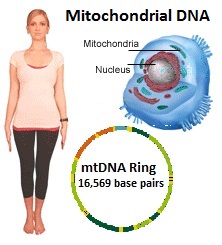 Mitochondrial
DNA Revisit: In Newsletter No. 261 (November 30, 2015), I wrote about mitochondrial DNA
(it descends down the female line) and noted I had a mtDNA "match" with a person who had
HVR1+HVR2 results that were done in 2007. At that time, he was designated as a T4, a category
later changed to T2a1b when more data made it clear that "T4" was really in the T2 line. For us,
this was good news, as T2a1b is a parent haplogroup to my T2a1b1a1b, so this put us a
number of mutations closer together than if he really was a T4 (which would have implied that
our most recent common ancestor was T). Based on our discussions about this, he decided to have
the full sequence test done... and those results are now available. It turns out that he
is an exact match to me: we are both T2a1b1a1b and all of our "Extra"
and non-defining mutations also match, meaning we have a GD (genetic distance) of 0.
Mitochondrial
DNA Revisit: In Newsletter No. 261 (November 30, 2015), I wrote about mitochondrial DNA
(it descends down the female line) and noted I had a mtDNA "match" with a person who had
HVR1+HVR2 results that were done in 2007. At that time, he was designated as a T4, a category
later changed to T2a1b when more data made it clear that "T4" was really in the T2 line. For us,
this was good news, as T2a1b is a parent haplogroup to my T2a1b1a1b, so this put us a
number of mutations closer together than if he really was a T4 (which would have implied that
our most recent common ancestor was T). Based on our discussions about this, he decided to have
the full sequence test done... and those results are now available. It turns out that he
is an exact match to me: we are both T2a1b1a1b and all of our "Extra"
and non-defining mutations also match, meaning we have a GD (genetic distance) of 0.
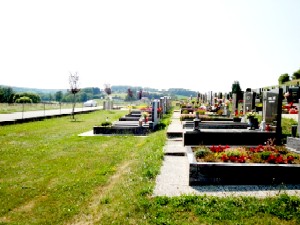 Nine
Burgenland Cemeteries Added to FindAGrave.com: BB member Kim Di Roberts reports that she
has completed the addition of nine Burgenland cemeteries to the
Nine
Burgenland Cemeteries Added to FindAGrave.com: BB member Kim Di Roberts reports that she
has completed the addition of nine Burgenland cemeteries to the
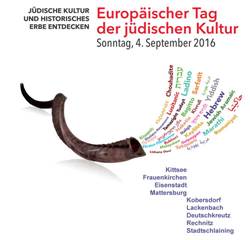 European
Day of Jewish Culture in Burgenland: The European Day of Jewish Culture, to be
held Sunday, September 4, is a joint project of the Burgenländische Forschungsgesellschaft,
the Österreichisches Jüdisches Museum, the Burgenländische Volkshochschulen and
the Landesmuseum Burgenland. The day consists of tours and lectures covering Jewish
culture and historical heritage in the towns of Kittsee, Frauenkirchen, Eisenstadt, Mattersburg,
Deutschkreutz, Lackenbach, Kobersdorf, Rechnitz, and Stadtschlaining.
European
Day of Jewish Culture in Burgenland: The European Day of Jewish Culture, to be
held Sunday, September 4, is a joint project of the Burgenländische Forschungsgesellschaft,
the Österreichisches Jüdisches Museum, the Burgenländische Volkshochschulen and
the Landesmuseum Burgenland. The day consists of tours and lectures covering Jewish
culture and historical heritage in the towns of Kittsee, Frauenkirchen, Eisenstadt, Mattersburg,
Deutschkreutz, Lackenbach, Kobersdorf, Rechnitz, and Stadtschlaining. Update
for book "The Burgenländer Emigration to America": Here is this month's update on
purchases of the English issue of the 3rd edition of Dr. Walter Dujmovits' book "Die
Amerika-Wanderung Der Burgenländer."
Update
for book "The Burgenländer Emigration to America": Here is this month's update on
purchases of the English issue of the 3rd edition of Dr. Walter Dujmovits' book "Die
Amerika-Wanderung Der Burgenländer."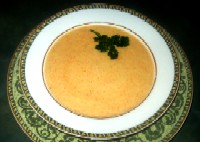 HUNGARIAN
GREEN PUMPKIN SOUP (from Vanessa Sandhu)
HUNGARIAN
GREEN PUMPKIN SOUP (from Vanessa Sandhu) Reminder:
As mentioned a few newsletters ago, I no longer have a "regular" source for Burgenland
recipes, as I've used up all I had. Vanessa Sandhu has shared five family recipes (the first
shown above), so I'm good for a few months, but then I'll be begging again! So, please consider
sharing your favorite Burgenland recipes or recipe books with me so I can share them with
the readership... and so our ethnic dishes do not get washed away by the ever flowing river of
time and become lost to our future generations. Thanks!
Reminder:
As mentioned a few newsletters ago, I no longer have a "regular" source for Burgenland
recipes, as I've used up all I had. Vanessa Sandhu has shared five family recipes (the first
shown above), so I'm good for a few months, but then I'll be begging again! So, please consider
sharing your favorite Burgenland recipes or recipe books with me so I can share them with
the readership... and so our ethnic dishes do not get washed away by the ever flowing river of
time and become lost to our future generations. Thanks!